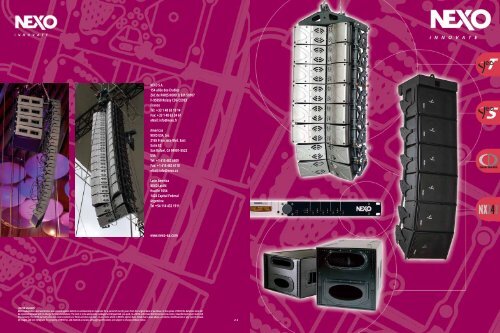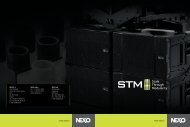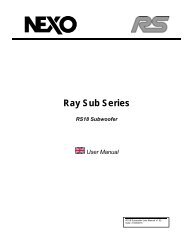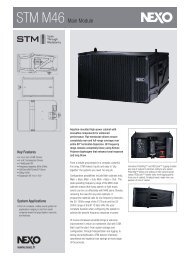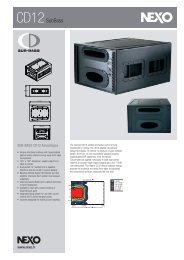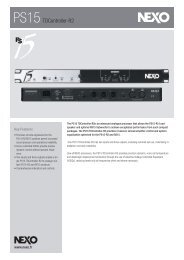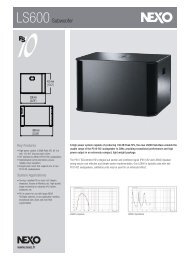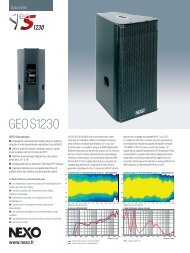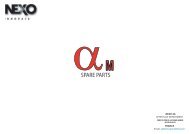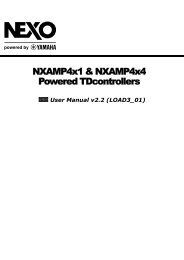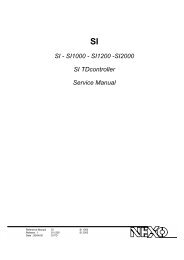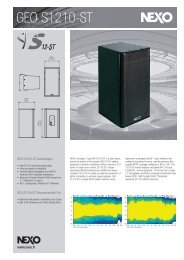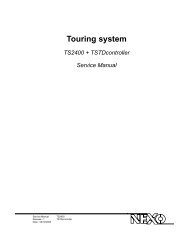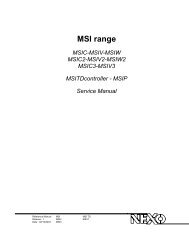geo t brochure - Nexo
geo t brochure - Nexo
geo t brochure - Nexo
Create successful ePaper yourself
Turn your PDF publications into a flip-book with our unique Google optimized e-Paper software.
<strong>Nexo</strong> GEO NoTab.QXD 5/7/05 3:35 pm Page 24<br />
NEXO S.A.<br />
154 allée des Erables<br />
ZAC de PARIS NORD II B.P. 50107<br />
F-95950 Roissy CDG CEDEX<br />
France<br />
Tél: +33 1 48 63 19 14<br />
Fax: +33 1 48 63 24 61<br />
eMail: info@nexo.fr<br />
Americas<br />
NEXO USA, Inc<br />
2165 Francisco Blvd. East<br />
Suite E2<br />
San Rafael, CA 94901-5522<br />
USA<br />
Tel: +1 415 482 6600<br />
Fax: +1 415 482 6110<br />
eMail: info@nexo.cc<br />
Latin America<br />
NEXO LatAM<br />
Hualfin 1054<br />
1424 Capital Federal<br />
Argentina<br />
Tel +54 114 432 1911<br />
www.nexo-sa.com<br />
LIMITED WARRANTY<br />
NEXO loudspeakers and electronics are covered against defects in workmanship or materials for a period of two (2) years from the original date of purchase. At the option of NEXO the defective item will<br />
be repaired/replaced with no charge for materials/labour. The item is to be adequately packaged and dispatched, pre-paid, to a NEXO authorised distributor/service centre. Unauthorised repair shall void<br />
the warranty. The NEXO warranty does not cover cosmetics or finish and does not apply to any items which in NEXO’s opinion have failed due to used abuse, accidents, modifications or any type of misuse.<br />
All images and text herein are the property of NEXO SA, and deemed accurate, although specifications are subject to change without notice. v1.5
<strong>Nexo</strong> GEO NoTab.QXD 5/7/05 3:35 pm Page 2<br />
CONTENTS<br />
NEXO and the Genesis of<br />
GEO systems 2<br />
Introduction to GEO S<br />
and GEO T 3<br />
GEO Tangent<br />
Systems Technology 4<br />
GEO Tangent<br />
Systems Performance 5<br />
GEO T4805 module 6<br />
T 4805 Technical &<br />
Architect Specs 7<br />
GEO T2815 Module 8<br />
T 2815 Technical &<br />
Architect Specs 9<br />
GEO T Connections<br />
and Arrays 10<br />
GEO & CD Rigging,<br />
Flying & Focus 11<br />
GEO S805 module 12<br />
S805 Technical &<br />
Architect Specs 13<br />
GEO S830 module 14<br />
S830 Technical &<br />
Architect Specs 15<br />
GEO S Rigging &<br />
Horizontal Arrays 16<br />
GEO Soft 17<br />
GEO CD18 Sub-Bass 18<br />
CD18 Technical &<br />
Architect Specs 19<br />
Geo CD12 Sub-Bass 20<br />
CD12 Technical &<br />
Architect Specs 21<br />
NX242 Digital Controller 22<br />
NX242 Technical Specs 23<br />
NEXO Contact Data & www.<br />
address, NEXO Warranty 24<br />
SMALLER<br />
AND BETTER<br />
Digital technology changed everything<br />
about audio and the music listening<br />
experience. Beyond obvious<br />
improvements in system performance,<br />
the greatest change was in expectations.<br />
Modern audiences compare live event<br />
sound with affordable, pristine personal<br />
or residential playback systems and, in<br />
doing so, add “fidelity” as a live concert<br />
requirement. Today’s audiences expect a<br />
CD-quality mix from a concert PA, only<br />
on a “bigger” scale than at home, and<br />
without significant fidelity loss.<br />
COHERENCY, TRANSPARENCY, FIDELITY<br />
Today, bigger sound is easy. Nearly every touring<br />
loudspeaker system offers overwhelming power<br />
and full-range frequency response. “Better”<br />
however, remains elusive, and the elusive<br />
component in “better” concert sound is coherency.<br />
Coherency is easily achieved in controlled, directfield<br />
environment such as car stereos or MP3<br />
earbuds. To a layman’s ears, performance<br />
loudspeaker coherency is what happens when the<br />
rare concert makes them feel as they do when<br />
listening in their home or car, only much “bigger”.<br />
More common to our shared experience<br />
is the lack of coherency caused when<br />
loudspeaker systems create spectrum-wide,<br />
audible coloration (i.e. constant peaks or dips in<br />
frequency response). These tonal imbalances<br />
inevitably leave dissatisfied audiences as aware<br />
of sound system performance as they are of the<br />
on-stage performance. This is why transparent,<br />
coherent sound reinforcement is the overriding<br />
design criteria behind GEO S and GEO T.<br />
Above: Infinitely precise<br />
rigging hardware<br />
maximizes the coherency<br />
of GEO’s wavefront.<br />
NEXO S.A.<br />
Now in its fourth decade, NEXO’s company mission is<br />
In the 1990s the film industry used<br />
digital audio to deliver a “bigger and<br />
TIME, SPACE, FREQUENCY<br />
Coherency applies to sound system transparency<br />
in the three-dimensional context of Time, Space<br />
Most naturally occurring sound sources<br />
however, such as unamplified singers or<br />
instrumentalists, never present listeners with<br />
to provide wide-ranging solutions that enhance the better” challenge to the comparatively<br />
and Frequency. At issue are Comb Filters, the multiple arrivals (i.e. comb filters). As such,<br />
science, art and commerce of sound reinforcement.<br />
audible, undesirable sound system artifacts human hearing never evolved to interpret<br />
tame at-home video experience. Movie<br />
Founded by Michael Johnson, NEXO’s Managing<br />
caused by closely-spaced peaks and notches in amplified sounds, and our ear-to-brain<br />
Director, and Chairman/R&D Director Eric Vincenot, seats were suddenly filled again,<br />
the frequency domain, and multiple arrivals in connections never adapted to the relatively<br />
NEXO became a publicly traded company in May<br />
2000. NEXO shares are listed on the Marche Libre of<br />
reversing decades of declining film<br />
revenues. Steady sales growth in home<br />
the time domain with very short time<br />
differentials and similar amplitudes. As multiple<br />
modern comb filter. Moreover, even when comb<br />
filters seem comparatively “fine” and not clearly<br />
the Paris Bourse (SICOVAM 4441).<br />
theater systems only reinforces the<br />
arrivals become widely separated in time (and audible, they continue to make it difficult to<br />
The added access to capital markets<br />
space), coherency is lost. Meanwhile frequency “hear what is going on.” This is especially true<br />
fact that people will pay for “bigger<br />
gained by this public offering strengthened NEXO’s<br />
response displays wide peaks and dips which for HF percussive sounds or vocal consonants.<br />
and better”, especially when the<br />
ability to pursue aggressively genuine audio<br />
change depending on spatial positioning of the<br />
No electronics will fix this situation. A<br />
innovations. The first of these advanced audio emphasis is on better. NEXO innovation<br />
listener and sound sources.<br />
whole-system EQ curve can never really “flatten”<br />
design options is the widely heralded GEO Tangent has taken this trend to its logical<br />
these peaks and dips. At some locations and<br />
technology, which incorporates several fundamental conclusion. With GEO, we offer sound<br />
certain frequencies, equalization will actually<br />
wave-source patents.<br />
reinforcement systems that are<br />
TOTAL COHERENCY<br />
make things worse. At others, presumably FOH, it<br />
NEXO’s sound reinforcement systems also<br />
GEO S Array (as rigged at left)<br />
might make them better. Only true system<br />
smaller and better. We think of it as a<br />
include the compact, versatile PS Series plus the<br />
8X GEO S805<br />
coherency will allow engineers to execute<br />
high performance Alpha System and Alpha e Series. In win-win solution, without compromise.<br />
1X GEO S830<br />
effective tonal adjustments that will work at<br />
short, all NEXO loudspeakers, analogue and digital<br />
controllers, power amplification, and advanced<br />
rigging systems are designed to deliver: Sonic<br />
Innovation That Works. NEXO is a world leader in the<br />
2X CD12<br />
Total Length: 2.15m (7.05ft)<br />
Total Width: 600mm (1.96ft) (at front)<br />
Total Weight: 193kg(414.6lbs)<br />
every seat and for every pair of ears. This is why,<br />
at NEXO, our pursuit of coherency drove the three<br />
years of R&D that delivered GEO. We’re extremely<br />
proud of the results.<br />
design and manufacture of loudspeaker systems for<br />
NOTHING ELSE COMPARES<br />
www.nexo-sa.com<br />
sound reinforcement.<br />
2 3
<strong>Nexo</strong> GEO NoTab.QXD 5/7/05 3:36 pm Page 4<br />
GEO SCIENCE<br />
& SOLUTIONS<br />
GEO HRW (reflective) Wavesources are:<br />
■ Very accurate<br />
■ Extremely compact<br />
■ Capable of Perfect Array Coupling<br />
Through combining Wavefronts<br />
■ Exceptionally versatile<br />
Photo1: GEO S Wavesource<br />
with Configurable Directivity<br />
Device flanges.<br />
the woofer up to at least 1200Hz.<br />
In practice, we can’t expect to centre 8-<br />
inch woofers closer than 10 inches, otherwise<br />
they will be a full wavelength apart at 1300Hz<br />
and adjacent woofers will start to become<br />
separate sources at 325Hz (1/4 wavelength<br />
spacing) and will begin to develop individual<br />
lobes at 625Hz. This frequency is far too low to<br />
cross over into the compression driver.<br />
The solution was GEO’s Directivity/<br />
Phase Device (DPD) (see Photo 3) on each cone,<br />
which causes 8-inch woofers to behave like twin<br />
4-inch drivers with two acoustical centres<br />
spaced 5 inches. The DPD extends the upper<br />
frequency limit for line source coupling between<br />
adjacent woofers. As such, GEO system’s 8-inch<br />
Fig 2: Coherency through<br />
GEO Wave Propogration.<br />
Tangent wavefronts<br />
radiate from common<br />
virtual array source.<br />
MEASUREMENT CONFIRMED<br />
To realise coherency, our most pressing design<br />
challenge was development of a sound system<br />
that allowed a multiple full-range cabinets to<br />
behave as if they share a single sound source.<br />
Obviously, this required acoustic coupling<br />
between multiple cabinets, but GEO Technology<br />
goes far beyond traditional line arrays. In fact,<br />
had we not been able to achieve coherency<br />
beyond the mid-to-HF coupling inherent in nearly<br />
every existing line array, NEXO would never have<br />
entered the vertical array marketplace.<br />
The point is that a Brüel and Kjaer<br />
Acoustic Analysis system doesn’t care what<br />
system you place in front of its calibration<br />
microphone. Nor does advanced MATLAB<br />
software care what data you feed it. So, when<br />
these advanced measurement tools confirmed<br />
that GEO S and GEO T loudspeaker systems<br />
displayed superior sonic performance that<br />
exceeded even our rigorous standards, it was<br />
clear that GEO’s unique wavesource had<br />
redefined control of acoustic energy. Simply put,<br />
GEO’s hyperboloid acoustic reflector eliminates<br />
destructive interference, with the most coherent<br />
output of any loudspeaker, anywhere.<br />
Fig 2 (below left): HRW<br />
creates a virtual acoustic<br />
wavesource that is<br />
“outside” the loudspeaker<br />
cabinet.<br />
Photo 3: GEO S Directivity Phase Device<br />
One other GEO innovation that must be<br />
mentioned is the Configurable Directivity Device<br />
flanges (CDD). (see Photo 1) An unprecedented<br />
NEXO development that is easy to use once you<br />
know how and when, these devices allow system<br />
designers, especially those working on<br />
permanent installations, to precisely alter<br />
wavesource behaviour.<br />
GEO S Series loudspeakers ship with<br />
the flanges (120° dispersion in the noncoupling<br />
plane). In curved vertical arrays, CDD<br />
flanges can be used on the bottom two rows of<br />
curved vertical arrays, to fill in coverage gaps in<br />
the front rows or; on all rows of curved vertical<br />
arrays, in cases where 120° of horizontal<br />
coverage is preferred to 80°. In horizontal arrays<br />
of GEO S830s, the Configurable Directivity<br />
Device can be used to widen the array’s vertical<br />
coverage of from 80° to 120°.<br />
THE SUB-BASS SOLUTION<br />
While bringing coherency and cardioid<br />
performance to LF was a challenge, cardioid or<br />
hypercardioid control of extreme LF or sub-bass<br />
was the capstone of GEO system design. To<br />
achieve this we looked toward input transducer<br />
(i.e. microphone) design.<br />
Microphones have long offered cardioid<br />
polar patterns. As such, cardioid loudspeakers<br />
can be simply described as a “cardioid mic in<br />
reverse”. NEXO’s approach uses the interference<br />
between two arrivals of the same amplitude in<br />
order to create off-axis rejection with rear<br />
reduction as high as -15dB. We apply the<br />
interference between two sources of identical<br />
amplitude to radiate a cardioid polar pattern with<br />
off-axis attenuation (see Fig 3).<br />
To achieve this, NEXO R&D designed<br />
advanced electronic control algorithms to allow<br />
NX242 TDcontrollers to maximise SubBass<br />
pattern control for CD12 and CD18 cabinets. For<br />
more information regarding sub-bass control<br />
please see pg 20. For more information on NX242<br />
please see pg 22.<br />
THE GEO HYPERBOLOID REFLECTIVE<br />
WAVESOURCE<br />
Hyperboloid Reflective Wavesource (HRW)<br />
technology produces precise and predictable<br />
results so that GEO wavesources couple<br />
enclosure. It also provides a virtual source that is<br />
behind the rear of the enclosure. As such, GEO<br />
wavesource measurements display a high degree<br />
of correspondence between mathematical<br />
predictions and real world results.<br />
optimally without destructive interference. This<br />
is why the GEO rigging system is designed to<br />
control angular splay to 0.01° precision.<br />
The key to GEO’s success however is in<br />
the innovative method that the HRW uses to<br />
control acoustic energy so that users can craft<br />
high-output wavefronts to precisely fit audience<br />
areas, more coherently and more evenly, than<br />
previously possible.<br />
The HRW wavesource (see Figure 1 &<br />
Photo 1) controls acoustic energy with an<br />
acoustical reflector (i.e. mathematically<br />
calculated hyperboloid acoustic mirror, derived<br />
from a rigorous set of <strong>geo</strong>metrical<br />
transformations). Thus the HRW creates a virtual<br />
acoustic wavesource that is “outside” the<br />
loudspeaker cabinet (see Figure 2).<br />
HOW IT WORKS<br />
As mentioned, GEO devices can use a HRW to<br />
position a virtual sound source “behind” the<br />
physical enclosure (see Figure 2). Notice that the<br />
path lengths from the virtual and real sources,<br />
to the horn mouths, are identical at the coupling<br />
points.<br />
This is the critical concept. Where the<br />
two wavefronts touch they will therefore be in<br />
phase because the pressure wave takes the<br />
same amount of time to travel an identical path<br />
length to the coupling point, regardless of where<br />
its real source is located in relation to that<br />
coupling point.<br />
This was difficult to achieve and not the<br />
only technical challenge involved. Several other<br />
Photo 4: GEO T Directivity Phase Device<br />
cone driver loses neither power handling, nor LF<br />
extension. In the GEO S Series, the DPD takes<br />
the form of a phase plug that is attached to the<br />
frame of the cone transducer. In the GEO T<br />
Series, the DPD is part of the molding that also<br />
includes the Configurable Directivity Device (see<br />
Photo 4).<br />
Also, because GEO T uses two 8-inch<br />
cone woofers and 1-inch compression drivers, the<br />
GEOT woofer must operate up to at least 1200Hz.<br />
As such, GEO T’s LF coupling performs in nearly<br />
identical fashion to non-cardioid arrays, in that<br />
BIG PICTURE<br />
A GEO Tangent Array is not a “line array” GEO<br />
Technology is equally effective in designing and<br />
deploying tangent horizontal arrays or curved<br />
vertical arrays. For best results in a specific<br />
application most users need to know how multispeaker<br />
arrays interact with audience <strong>geo</strong>metry,<br />
along with the benefits and drawbacks of curved<br />
vertical arrays and horizontal arrays.<br />
The cardioid works in the vertical as<br />
well as the horizontal plane and it is therefore<br />
pretty obvious that the effect will be much more<br />
impressive in a small array. As the array becomes<br />
larger/longer (and most often flatter as a<br />
consequence of its length) the HF couples very<br />
effectively and becomes more prominent than the<br />
This patent-pending technique allows design obstacles also had to be overcome. For<br />
our smaller arrays have proportionally more bass LF, while LF increases nearly proportionally to the<br />
Fig 1: Computer<br />
Rendered, GEO S805<br />
the designer to locate the real source (the example, GEO S uses 8-inch cone woofers and 1<br />
than large ones, because the LF interfering quantity of cabinets, without the need for<br />
Wavesource<br />
compression driver) almost anywhere inside the inch compression drivers, so we need to operate<br />
effects are much smaller.<br />
extensive LF equalisation.<br />
Fig 3: Cardoid sub-bass coverage from CD SubBass<br />
4 5
<strong>Nexo</strong> GEO NoTab.QXD 5/7/05 3:36 pm Page 6<br />
120<br />
60<br />
0<br />
60<br />
GEO T4805<br />
A compact, extremely high-output array<br />
module, the T4805 is the centerpiece to GEO T<br />
vertical tangent array system design. The 5°<br />
Hyperboloid Reflective Wavesource is<br />
optimized so that multiple GEO loudspeakers<br />
coherently radiate tangent wavefronts,<br />
allowing these curved vertical arrays to<br />
deliver consistent front-to-rear SPL across<br />
all coverage areas. Advanced DSP<br />
algorithms, applied by the NX242<br />
TDcontroller, provide GEO T systems with<br />
unrivalled midbass directional control.<br />
COUPLING PLANE COVERAGE (°)<br />
GEO T4805 rear view<br />
NON-COUPLING PLANE COVERAGE (°)<br />
120<br />
60<br />
0<br />
60<br />
<strong>Nexo</strong> GEO NoTab.QXD 5/7/05 3:36 pm Page 8<br />
120<br />
60<br />
0<br />
60<br />
120<br />
GEO T2815<br />
A compact, extremely high-output array<br />
module, the versatile T2815 is often used at<br />
the bottom of T4805 vertical tangent arrays<br />
(see pg #9), and in traditional horizontal<br />
arrays. The 15° Hyperboloid Reflective<br />
Wavesource is optimized so that multiple<br />
T2815s coherently radiate tangent<br />
wavefronts, when used in curved vertical<br />
arrays, to deliver consistent front-to-rear<br />
SPL across all coverage areas. Twin rearfiring<br />
passive resistors provide exceptional,<br />
passive midbass directional control.<br />
COUPLING PLANE COVERAGE (°)<br />
GEO T2815 rear view<br />
120<br />
60<br />
0<br />
60<br />
120<br />
NON-COUPLING PLANE COVERAGE (°)<br />
<strong>Nexo</strong> GEO NoTab.QXD 5/7/05 3:36 pm Page 10<br />
Fig 3: BLGEOT12-30<br />
GEO T SERIES ARRAY<br />
ASSEMBLY SYSTEM<br />
No portable loudspeaker system,<br />
intended for the ups and downs of touring<br />
sound, is really road-worthy without a<br />
quick and user-friendly flying and<br />
transport system. We believe our GEO T<br />
Series Array Assembly System (TSAAS) to<br />
be the most elegant and quite likely the<br />
fastest rigging system available.<br />
Our system enables various system<br />
configurations to be flown with a<br />
minimum quantity of motor hoists. Most<br />
importantly, the TSASS’s custom-designed<br />
permits easy deployment while being<br />
functionally optimised to match precisely<br />
the mechanical and acoustical<br />
characteristics of GEO T2815 and GEO<br />
T4805 Array Modules.<br />
Photo 1 (above):<br />
Connecting two GEO<br />
T4805s with integral<br />
cabling and Amphenol<br />
EP6 connector<br />
GEO T4805 ships<br />
with TSASS Rigging<br />
Hardware<br />
GEO T2815 ships<br />
with TSASS Rigging<br />
Hardware<br />
VERTICAL ARRAYS<br />
Vertical and horizontal arrays are unique in their<br />
behaviour and intended applications. Vertical<br />
GEO arrays are intended for applications where<br />
the horizontal coverage (GEO S 80º or 120º, or<br />
GEO T 90º) is suitable and even SPL from the<br />
first row to the last row of the audience is<br />
desired (everywhere).<br />
Properly deployed, GEO Series systems<br />
can provide extremely even SPL throughout the<br />
depth of your audience, including balcony<br />
coverage.<br />
HORIZONTAL ARRAYS<br />
Horizontal arrays deliver equal power to equal<br />
angles, with SPL decreasing as distance<br />
increases. Horizontal arrays of GEO S830 and<br />
GEOT 2815 cabinets provide exceptional control<br />
of horizontal coverage but are not intended to<br />
provide the same even SPL capability as a GEO<br />
tangent vertical array.<br />
For more information see pg #16.<br />
FLYING VERTICAL<br />
The GEO T Series Array Assembly System requires<br />
three experienced persons for set-up: typically<br />
one motor hoist operator, and one GEO T operator<br />
per side of the cluster. When properly used and<br />
maintained, TSASS will provide many years of<br />
reliable service. Vertical angle adjustment<br />
between cabinets has been limited to specific<br />
settings to ensure coherent acoustic coupling.<br />
There are 5 main parts to the Geo T flying system:<br />
1. The main flying bumper<br />
2. The main kelping beam<br />
3. The GEO T cabinets<br />
4. The kelping plate or lower pull up assembly<br />
5. The kelping chain and clutch assembly<br />
Each GEO T Array Module includes an<br />
individual rigging system, which is factorymounted<br />
by NEXO. GEO T Series Tangent Array<br />
Modules are transported pre-pinned in a flight<br />
case of three cabinets (see photo 2).<br />
Six BLGEOT12-30 locking pins (see Figure #1)<br />
are provided with the GEO T4805 and four<br />
BLGEOT12-30 locking pins are provided with the<br />
GEO T2815. All holes on GEO T side rigging<br />
plates are 12mm diameter, and match the<br />
12mm diameter x 30mm length pins.<br />
PRECISION FOCUS - HOW IT WORKS<br />
Because GEO T arrays require very high<br />
accuracy, angle sequences follow a logarithmic<br />
scale. Angle setting values are:<br />
Bumper to GEO T4805: 0°<br />
GEO T4805 to GEO T4805: 0.125° - 0.20° -<br />
0.315° - 0.50° - 0.80° - 1.25° - 2.0° - 3.15° - 5.0°<br />
GEO T4805 to GEO T2815: 6.30° - 8.00° - 10.0°<br />
GEO T2815 to GEO T2815: 6.30° - 8.00° - 10.0° -<br />
12.5° - 15°<br />
TSASS deploys in either Tension mode or<br />
Compression mode (see Figure 4). In Tension<br />
Mode, angles between cabinets are set by the force<br />
of gravity applied from top to bottom of the array.<br />
When the array is lifted into position, each module<br />
will fall automatically into the proper angle.<br />
In Compression Mode, angles between<br />
cabinets are set by a pull-back force applied from<br />
bottom to top of the array. When the array is lifted<br />
into position, all cabinets are at 0°, and when the<br />
pull-up force is applied, each module is lifted<br />
from the rear into the proper angle(see Figure 5).<br />
CD18 RIGGING<br />
Compared to the precise aiming required by GEO<br />
T arrays, CD18 SubBass rigging is relatively<br />
simple. Each CD18 is designed to stack directly<br />
on top of and/or below another CD18. The<br />
vertical stacks are required to realize maximum<br />
LF performance, and of course, there is a front<br />
and rear to each CD cabinet.<br />
Although flying rigging is available for<br />
CD 18s, they are most frequently stage/ground<br />
stacked. To maximize CD18, or CD12 groundstacked<br />
cardioid characteristics, a free (open)<br />
Fig 4: Tension mode<br />
space is needed directly behind the SubBass<br />
stack. Therefore, whenever possible, users should<br />
avoid placing the devices against any rear<br />
barriers such as back walls or staging barriers.<br />
TRANSPORT<br />
As mentioned, the GEO T Series cabinets travel<br />
conveniently, in groups of three, when packed<br />
in NEXO-provided castered flight cases.<br />
Although relatively compact, the<br />
CD18 is too large for individual<br />
flight cases, and as such requires<br />
its own castered wheelboard for<br />
easily handling.<br />
Fig 5: Compression mode<br />
Photo 3 (below): GeoSight<br />
Inclinometer System.<br />
(cabling not shown)<br />
GEOSIGHT INCLINOMETER<br />
As a high-performance, optics-derived system,<br />
successful GEO T deployment requires precise<br />
focus (i.e. aiming). Experienced users often<br />
apply laser-aiming procedures once their GEO T<br />
system is airborne.<br />
The NEXO GeoSight Inclinometer<br />
System was specifically designed for installation<br />
of NEXO Geo Tangent Array Series systems. While<br />
not the only method of achieving a coherent<br />
wavefront, proper GeoSight use enables accurate<br />
GEO T array installation in minimum time. Visit<br />
our website at www.nexo-sa.com, or contact<br />
your NEXO agent, for more GEOSight information.<br />
This <strong>brochure</strong> text is not intended as a rigging user manual, but rather to provide the<br />
general system details used in GEO T system rigging.<br />
The GEO T Array Assembly System is a professional precision tool and should be handled<br />
with extreme care. Only persons who are fully conversant with the operation<br />
of the GEO T Series Array Assembly System and provided with suitable safety equipment<br />
should install and operate the system.<br />
Misuse of the GEO T Series Array Assembly System could lead to dangerous<br />
consequences. Also there are several potential dangers: we won’t list all of them here.<br />
We will mention possibly the most important operational warning: never put your fingers<br />
Photo 2 (above): GEO T4805s<br />
into the side rigging plates!<br />
www.nexo-sa.com<br />
packed in castered flightcase<br />
10 11
<strong>Nexo</strong> GEO NoTab.QXD 5/7/05 3:36 pm Page 12<br />
120<br />
60<br />
0<br />
60<br />
120<br />
GEO S805<br />
The GEO S805 is compact, high-output array module<br />
designed for use in vertical tangent arrays. The Hyperboloid<br />
Reflective Wavesource allows multiple GEO S8 loudspeakers<br />
to radiate tangent wavefronts with coherent output.<br />
The 5° wavesource is optimized for the construction of<br />
curved vertical arrays that deliver equal power to equal<br />
coverage areas for consistent SPL from front to rear of the<br />
audience area.<br />
Advanced DSP algorithms, applied by the NX242 TDcontroller,<br />
precisely integrate GEO S systems with CD12 SubBass<br />
cabinets, so they may be flown together, without causing any<br />
interference between the GEO S and CD12 wavefronts.<br />
COUPLING PLANE COVERAGE (°)<br />
120<br />
60<br />
0<br />
60<br />
120<br />
S805 Front view with grill<br />
S805 Rear view<br />
NON-COUPLING PLANE COVERAGE (°)<br />
<strong>Nexo</strong> GEO NoTab.QXD 5/7/05 3:36 pm Page 14<br />
120<br />
60<br />
0<br />
60<br />
120<br />
10<br />
0<br />
10<br />
20<br />
GEO S830<br />
The compact GEO S830 is a high-output array<br />
module intended for horizontal tangent arrays or<br />
as a downfill element in curved (tangent) vertical<br />
arrays to establish consistent SPL in all coverage<br />
areas. The HRW allows the 30° S830 and 5°<br />
S805 to be coherently arrayed together.<br />
GEO S Series loudspeakers ship with 120°<br />
dispersion (in the non-coupling plane)<br />
Configurable Directivity Devices (CDD), but are<br />
field-changeable to 80° CDDs. To maximize downfill<br />
coverage, CDFs are used on GEO S830s for the<br />
bottom two rows of curved vertical arrays.<br />
COUPLING PLANE COVERAGE (°)<br />
100Hz 1kHz 10kHz<br />
3 GEO S830 @ 30° Off-Axis Response<br />
ON-AXIS RESPONSE (dB)<br />
30<br />
100Hz 1kHz 10kHz<br />
3 GEO S830 @ 30° On-Axis Response Wideband (Dark), Ground (light), Flown (Black)<br />
120<br />
60<br />
0<br />
60<br />
120<br />
256<br />
128<br />
64<br />
32<br />
16<br />
8<br />
S830 Rear view<br />
S830 Front view with grill<br />
NON-COUPLING PLANE COVERAGE (°)<br />
100Hz 1kHz 10kHz<br />
GEO S830, 120° CDD Configuration Off-Axis Response<br />
IMPEDANCE (Ohm)<br />
4<br />
100Hz 1kHz 10kHz<br />
GEO S830 Impedance<br />
<strong>Nexo</strong> GEO NoTab.QXD 5/7/05 3:36 pm Page 16<br />
©2004 NEXO SA<br />
Tech Support:<br />
+33 14 48 63 19 14<br />
technical @ nexo.fr<br />
www.nexo-sa.com<br />
GEO S RIGGING<br />
The GEO S Array System is a professional rigging<br />
system, and should be handled with extreme care.<br />
GEO S850 and S830 loudspeakers are shipped<br />
from the factory with identical array assembly<br />
hardware. The GEO Array Assembly has three<br />
attachment points on each side (see Photo). The<br />
points in the front connect each GEO cabinet to<br />
the adjacent enclosures above and below.<br />
The angle between cabinets is set by<br />
attaching one end of the angle-setting bar to the<br />
proper hole on the angle-setting plate which<br />
extends beyond the rear of the cabinet. The GEO<br />
S Bumper is symmetrical, enabling you to use<br />
GEO loudspeakers in a left/right stereo<br />
configuration. The connection between the top<br />
GEO S enclosure and the bumper determines the<br />
left/right orientation for the entire array.<br />
GEO S830s with hardware<br />
for horizontal rigging.<br />
Angle-setting bar as used<br />
between two GEO S<br />
sideplates to adjust<br />
tangent array curvature.<br />
coverage and, where the <strong>geo</strong>metry is suitable,<br />
either GEO S or GEO T horizontal arrays will<br />
deliver a coherent wavefront in the midrange<br />
and high frequencies.<br />
GEO S830 allows users to provide 30º<br />
increments of horizontal coverage as needed.<br />
Where the <strong>geo</strong>metry is suitable, GEO arrays will<br />
deliver a coherent wavefront consisting of 30°<br />
tangent arcs that is more intelligible and<br />
reveals more musical detail than the incoherent<br />
sound produced by arrays using multiple<br />
conventional horns, which must be separated in<br />
space and time.<br />
The GEO S830 is designed to array<br />
tangentially with adjacent S830 cabinets to<br />
provide a much more coherent wave front from<br />
an array of multiple cabinets than<br />
conventional arrayable cabinets Where the<br />
best fit to the <strong>geo</strong>metry of the listening area is<br />
a single row of horizontally-arrayed speakers,<br />
GEO technology provides a coherent source of<br />
midrange and high frequency energy. This is<br />
because GEO wavesources produce a curved<br />
wavefront using hyperboloid acoustic mirrors<br />
instead of angled sidewalls.<br />
As explained in GEO SCIENCE &<br />
SOLUTIONS on pg #4, a hyperboloid, a GEO<br />
wavesource exhibits dual sources: a real source<br />
and a virtual source. The GEO design process<br />
puts the virtual source behind the enclosure, and<br />
these virtual sources can be perfectly aligned.<br />
GEO SOFT 2<br />
COLD HARD ELECTRO-ACOUSTIC FACTS<br />
Due to the complex interaction between<br />
multiple loudspeaker cabinets, it is simply<br />
impossible to design curved vertical arrays<br />
reliably without using computer processing to<br />
predict the optimum array structure for any<br />
real-world audience <strong>geo</strong>metry.<br />
Still, the required design logic is far<br />
more complex than looking at a section drawing<br />
of the venue, measuring the overall angle needed<br />
to cover the audience from the cluster location,<br />
and dividing by 5º to determine the required<br />
number of GEO T4804 or S805 cabinets.<br />
ENTER GEOSOFT 2.0<br />
Simply put, GEOSoft v2 is another component of<br />
NEXO's integrated systems technology and a<br />
design tool that advances maximizes GEO<br />
loudspeaker performance. More precisely,<br />
GEOSoft v2 is three-dimensional, powerful and<br />
highly predictive R&D simulation software that<br />
processes measured speaker data with complex<br />
mathematical algorithms. The results assist<br />
GEO Series loudspeaker array deployments in<br />
delivering uniform SPL throughout the width<br />
and depth of any venue.<br />
Windows 98<br />
Windows 2000<br />
T Series Array Assembly System<br />
(TSASS)-see pg#10) and S series array<br />
assembly hardware (see pg #16) are keyed to<br />
GEOSoft v2, so that v2 software users can<br />
design vertical GEO arrays and tailor each<br />
array’s wavefront to match audience topology,<br />
providing equal power to equal areas.<br />
GEOSoft v2 also precisely<br />
creates/predicts system pressure levels to<br />
determine the number of loudspeaker cabinets<br />
needed for the application, as well as<br />
mechanical constraints for safely flown systems,<br />
in agreement with Structural Analysis Reports<br />
(available in the Help section): dimensions,<br />
weight, gravity center position, forces, moments,<br />
working load and safety factor.<br />
NOTE: While GEOSoft v2 is an elegant acoustic<br />
prediction tool, it provides no information<br />
regarding safe assembly. Safety issues<br />
regarding installation and handling are fully<br />
detailed in each GEO User Manual Safety Section.<br />
NEXO’s Web Site (www.nexo-sa.com)<br />
periodically provides GEOSoft upgrades.<br />
HORIZONTAL ARRAYS<br />
We wish this <strong>brochure</strong> were large enough to explain every option of GEO S and GEO T system versatility.<br />
Unfortunately it isn’t, so we ask you to remember that the following description of GEO S830 horizontal array<br />
deployment also applies to GEO T2815 design criteria, except of course with different coverage angles.<br />
Screen views of<br />
GEOSoft 2.0 Display<br />
GEO ARRAY & DEPLOYMENT FACTS<br />
GEO S TECHNOLOGY IN<br />
■ Horizontal arrays are the best solution for HORIZONTAL ARRAYS<br />
very wide coverage angles, such as stadium Do not think of GEO as only a vertical array<br />
bowls, arena “exploded clusters” and<br />
system. Horizontal arrays of GEO loudspeakers<br />
multiple balcony, opera-style theatres<br />
have relatively high power (because of the<br />
centre-coverage in L-R-C designs.<br />
narrow 30° horizontal array element) and wide<br />
■ Because the patented GEO HTW employs front to back coverage of 80° to 120°.<br />
an hyperboloid acoustic mirror rather than<br />
Horizontal arrays deliver equal power to<br />
side walls to control dispersion, multiple equal angles, with SPL decreasing as you move<br />
sources can share a common point of origin. further back in the audience. Because they are<br />
GEO S Sideplates are<br />
identical on both S805<br />
■ Because acoustic centers are in perfect limited to a single row (for a coherent wavefront<br />
and S830 models.<br />
alignment, GEO arrays do not display the without interference in the vertical plane),<br />
interference and lack of coherency that is horizontal arrays deliver “equal power to equal<br />
observed in conventional horn arrays.<br />
angles” and suited for a special set of audience<br />
■ In the non-coupling plane (the vertical or <strong>geo</strong>metries such as stadium bowls, arena<br />
horizontal arrays) GEO wavesources use a “exploded clusters”, opera-style theatres with<br />
diffraction slot. Field-installable flanges can multiple balcony levels and often as the centre<br />
thus widen the vertical dispersion and<br />
cluster in a L-C-R system.<br />
produce asymmetrical patterns.<br />
Horizontal arrays of GEO S830 cabinets<br />
16<br />
www.nexo-sa.com<br />
provide exceptional control of horizontal<br />
17
<strong>Nexo</strong> GEO NoTab.QXD 5/7/05 3:36 pm Page 18<br />
CD18 SUB-BASS<br />
Our CD18 SubBass has re-defined the art of<br />
VLF sound reinforcement in two significant<br />
ways. The sophisticated throat design profile<br />
is optimized to reduce unwanted "porting<br />
noise" at high SPL. More importantly, the<br />
CD18 applies “in reverse” microphone<br />
design techniques to produce a hypercardioid<br />
pattern from dual 18-inch<br />
horizontally-opposed woofers.<br />
DSP algorithms, from NEXO's new generation<br />
NX242 TDcontroller are individually applied to<br />
both dual-ported woofers, to yield highimpact,<br />
forward sub-bass gain for audience<br />
members, and create more than +15dB rear<br />
attenuation. No other sub-bass system can<br />
better direct VLF energy away from open<br />
microphones and reverberant surfaces,<br />
especially the rear wall.<br />
CARDIOD COVERAGE (°)<br />
120<br />
60<br />
0<br />
60<br />
120<br />
30Hz 100Hz 1kHz<br />
CD18 Vertical and Horizontal Off-Axis Response<br />
CD18 rear view<br />
SUPER CARDIOD COVERAGE (°)<br />
120<br />
60<br />
0<br />
60<br />
120<br />
30Hz 100Hz 1kHz<br />
CD18 Vertical and Horizontal Off-Axis Response<br />
<strong>Nexo</strong> GEO NoTab.QXD 5/7/05 3:36 pm Page 20<br />
CD12 SUB-BASS<br />
The compact CD12 exhibits innovative<br />
control of long wavelength LF energy. The<br />
CD12 applies microphone design<br />
techniques “in reverse” to produce a<br />
hyper-cardioid pattern from twin 12-inch<br />
horizontally-opposed woofers.<br />
Sophisticated DSP algorithms, from the<br />
NX242 TDcontroller are applied<br />
individually to both dual-ported woofers,<br />
to produce high-impact forward gain, and<br />
+12dB rear attenuation. This means CD12<br />
directs subbass energy towards the<br />
audience, and away from open<br />
microphones and reverberant surfaces,<br />
especially the rear wall.<br />
The CD12 is a hypercardioid subwoofer providing<br />
directional low-frequency output with dramatic<br />
LF reduction behind the cabinet(s). This is<br />
achieved by using the interaction of two<br />
independently-driven 12-inch drivers, highly<br />
specialised ports, and DSP control of the<br />
NX242TDcontroller.<br />
To maximize CD12 performance:<br />
■ Maintain at least one meter(3ft+) of free<br />
space around ground-stacked CD12(s). Objects<br />
or barriers within this space may interfere with<br />
controlled wavefront interaction.<br />
■ Drive the front and rear drivers with identical<br />
amplifier channels set to the same gain. CD12<br />
www.nexo-sa.com<br />
CD12 rear view<br />
CD12 front view<br />
<strong>Nexo</strong> GEO NoTab.QXD 5/7/05 3:36 pm Page 22<br />
NEXO’s new NX242 Digital TDController is an<br />
advanced, proprietary digital processor that<br />
maintains exceptional performance and<br />
reliability in GEO, Alpha and PS loudspeaker<br />
systems and associated Sub-basses. The NX242<br />
provides crossover, sensed-amplifier control<br />
and system alignment acoustically matched to<br />
each NEXO component. The NX242’s complex<br />
software algorithms integrate this calibrated<br />
data with sensed-voltage measurements, while<br />
analogue I/O functions share rear panel space<br />
with digital Audio Distribution and System<br />
Control over Standard Ethernet via<br />
EtherSound connection using the NXtension-<br />
ES4 Expander Board.<br />
MUCH MORE THAN EXPECTED<br />
The NX242 offers every conceivable “generic”<br />
Digital Loudspeaker Controller function, but its<br />
real value is precision interface with NEXO<br />
loudspeakers. For example, every NX242<br />
channel offers discrete simulation/protection<br />
processing and contains a combination of<br />
controlled gain stages (think of analogue VCAs),<br />
embedded into adaptive, complex composite<br />
signal chains with frequency-selective<br />
attenuation, similar to an analogue voltage<br />
controlled dynamic equaliser (VCEQ).<br />
Each VCEQ and VCA is controlled, via<br />
synthesis of several signals, with multiple<br />
detection sections. That synthesis is the envelope<br />
of those signals, with optimised release and<br />
attack times for each VCEQ and VCA (depending<br />
on cabinet and frequency range).<br />
NX242 also employs low and high-pass<br />
filters to filter potentially performance-degrading<br />
frequencies and maximize overall system<br />
response. High-pass filters also help prevent<br />
loudspeaker over-excursion at very low<br />
frequencies. Crossover function is tuned for every<br />
possible cabinet set-up and designed to optimize<br />
phase alignment throughout the crossover overlap<br />
region. Each crossover is customized so that each<br />
transducer will fit with its neighbour by achieving<br />
a perfect phase alignment. Unconventional,<br />
crossover-defined filters are applied, ranging from<br />
6dB/octave to near infinite slopes.<br />
EQ, TIMING & SENSE<br />
Time alignment is also unconventionally<br />
achieved, by combining crossover filter group<br />
delays with all-pass and/or frequency<br />
dependent delays. Active attenuation allows<br />
lowering of amplifier voltages for a given output<br />
SPL to maximum potential SPL. Active<br />
equalisation also extends a NEXO loudspeaker’s<br />
frequency response, especially at LF, where<br />
output is cabinet size-limited.<br />
The Sense-Input signal is routed to a<br />
shaping filter, producing a signal whose<br />
instantaneous amplitude is proportional to voice<br />
coil excursion. After rectification, this signal is<br />
compared to a preset threshold matching the<br />
maximum usable value, as determined from<br />
laboratory measurements. Any signal exceeding<br />
this threshold is sent to the VCEQ control buffer,<br />
while the VCEQ instantaneously acts as an<br />
excursion limiter.<br />
To avoid detrimental effects caused by<br />
very long release time constants inherent to any<br />
temperature detection signal (i.e system output<br />
being reduced for an extended period, “pumping”<br />
effects, etc.), the detection signal is modulated<br />
by another voltage integrated with faster time<br />
constants that match subjective "human" sound<br />
perception. This allows the NX242 to reduce<br />
temperature limiter operating durations to<br />
natural levels, while keeping protection<br />
thresholds as high as possible.<br />
the VCA, with its operation threshold slightly<br />
(3dB) above the temperature limiter.<br />
An optimised attack time constant<br />
allows operation without any subjectively<br />
unpleasant transient effects, while the useradjusted<br />
Peak Limiter threshold is set to match<br />
the amplifier’s clip point, avoiding any audible<br />
artifacts and loudspeaker damage caused by<br />
intense amplifier distortion, thus protecting<br />
against driver overheating and over-excursion.<br />
ETHERSOUND INSIDE<br />
EtherSound enhances NX242 functionality with<br />
easy-to-implement, high-quality audio networks<br />
utilising the NXtension-ES4. The patented<br />
EtherSound protocol provides full control with<br />
very low-latency (125µs, plus 1.6µs per<br />
additional network node) transmission of<br />
synchronized audio channels, over standard<br />
Ethernet. EtherSound’s cost effective, all digital<br />
path, between a nearly infinite numbers of<br />
networked audio devices, offers up to 64<br />
channels of 24-bit digital audio at 48KHz, plus<br />
bi-directional status and control data. Off-theshelf<br />
Ethernet components, such as 100baseTX<br />
switches can extend the number of audio<br />
devices, as well as the distance between<br />
network devices.<br />
NXTENSION-ES4 EXPANDER BOARD<br />
Central to the enhanced NX242’s enhanced<br />
processing and network functions, the<br />
NXtension-ES4 Expander Board adds Digital<br />
Inputs/Output plus remote control functions via<br />
the DIGIGRAM EtherSound Network. The NX242’s<br />
NEXO NXBoard-EtherSound interface provides<br />
four digital inputs and outputs, plus digital<br />
audio distribution over Ethernet with negligible<br />
propagation delay, allowing use in the most<br />
demanding live audio applications. Through an<br />
additional DSP chip and Flash memory, the<br />
NXtension Expander Board doubles NEXO NX242<br />
memory capacity, compared to NX241<br />
performance. In addition to digital input/output,<br />
the NXtension-ES4 provides full networking, or<br />
assignment and remote NX242 parameter<br />
control. The NXtension-ES4 also enables network<br />
remote installation survey, thanks to its native<br />
integrated networked status report capability.<br />
NXTENSION-CAI EXPANDER BOARD<br />
The NXtension-CAI Expander Board further<br />
enhances NX242 processing capacities with<br />
remote control functions directed by CAMCO<br />
WINCAI protocol. NX-CAI’s dual EtherCAi-WinCAI<br />
functions allow the NX242 to act as a bridge<br />
between the Ethernet and CAI networks. The<br />
EtherCAI-WinCAI interface provides full network<br />
or local remote control of all NX242 parameters<br />
including I/O meters and protection monitoring.<br />
Linked via Laptop, or through a standard<br />
Ethernet switch in star configuration, this<br />
protocol allows control of subsequent Vortex<br />
Amplifiers & NX242 Digital TDcontrollers daisychained<br />
through the CAI RS485 Network.<br />
NX242 FEATURES<br />
■ Precision circuits engineered for NEXO<br />
loudspeakers permit increased sound pressure<br />
and operational reliability.<br />
■ Flexible loudspeaker management for all NEXO<br />
loudspeaker systems, providing crossover, driver<br />
protection and system alignment.<br />
■ User-configurable inter-channel gain, delay<br />
and array EQ.<br />
■ Low and High-pass filters optimised to work in<br />
conjunction with overall system response.<br />
■ High-quality audio performance, 24bit data<br />
with 48bit accumulator; 100MIPS.<br />
■ 2x audio inputs, 4x audio outputs and 4 sense<br />
inputs enable a single NX242 to manage easily<br />
multiple NEXO cabinets across each product range.<br />
■ Comprehensive 16x2 character backlit LCD<br />
display, indicators and controls.<br />
■ Optional Remote Control, additional 100MIPS<br />
DSP and memory resources via the NXtension CAI<br />
expander board, based upon the CAMCO CAI<br />
protocol.<br />
■ Optional Remote Control, additional 100MIPS<br />
DSP and memory resources and link to the<br />
EtherSound Network (4in/4out) via the NXtension-<br />
ES4 expander Board.<br />
■ 4x NX242’s processed (digital) audio outputs to<br />
64x uncompressed channels of 24bit/48kHz of<br />
audio transmission over Ethernet.<br />
■ Updateable Flash EPROM (Firmware)<br />
Upgrades.<br />
NX242 PRODUCT SPECIFICATIONS<br />
Output Level +28dBu Max into 600Ω.<br />
Dynamic Range<br />
All Channels = 110dB.<br />
THD+N Output<br />
Typ 0.005% @ 1000Hz @ 27dBu.<br />
Latency Time<br />
2.2ms flat set-up<br />
Output Level<br />
110-220 Volts, 50-60Hz continuous operation (Operating range 90-264V)<br />
Audio Inputs<br />
2x L&R Heavy Duty Audio inputs, 24bit convertors; Electronically balanced and<br />
floating, 20kOhm. CMMR=80dB. 2x XLR 3 connectors.<br />
Sense Inputs<br />
4x Amplifier Sense-Inputs, 18bit converters; Floating 150kOhm. 8-Pole Removable<br />
Strip Terminal.<br />
Audio Outputs<br />
4x audio outputs, 24bit converters, Electronically balanced, 50Ohm.<br />
3x XLR-3M connectors.<br />
Processing<br />
24bit data with 48bit accumulator. 100MIPS.<br />
Front panel<br />
Menu A and Menu B buttons. 16 x 2 character backlit LCD Display. Select Wheel and<br />
Enter Button; Four MUTE/SOLO Buttons.<br />
Indicators<br />
4x Speaker Protect yellow LEDs. 4x green Amp Sense LEDs. 4x red Peak LEDs. 4x red<br />
Mute LEDs; 2x red LEDs; Input CLIP and DSP CLIP.<br />
Rear panel<br />
On/Off Mains switch; mains IEC socket; RS232 serial communications connector;<br />
Expansion slot for processor extension card;<br />
Flash/EPROM<br />
Software upgrades and new cabinet set-ups are available from NEXO web site.<br />
Dimensions<br />
1RU (19in) Width, 230mm (9in) Depth<br />
Weight<br />
3.8kg(8.8lbs) net<br />
USER CONTROLS<br />
System Selection Allows control from all NEXO ranges.<br />
System Set-up<br />
Within the selected range, allows the cabinet to be set for passive or active mode, aux,<br />
mono or stereo subs, wedge or FOH operations depending on system selected. Up to 80x<br />
factory pre-sets.<br />
Protection<br />
Peak Limiter, Displacement and Temperature protection on every channel; Physio control<br />
of the Protection limiter & compressors Soft Clip<br />
Automatic tracking of amplifier clip point<br />
Delay<br />
Up to 150m (465 ft.) of delay in 10cm (.4in ) steps; on Sub channel, Main channels or<br />
Sub + Main linked<br />
Input Sensitivity<br />
Level From 6dB to +12dB in 3dB steps.<br />
Output Level<br />
Global and inter-channel gain 6dB in 0.5dB steps.<br />
Amplifier Gain Reading Allows amplifier gain checking with program material.<br />
Mute/Solo<br />
Changes front panel buttons from Channel Mute to Solo<br />
Save/Recall<br />
Set-up Stores up to 10 user set-ups; On- the-fly recall, without mute or glitches for<br />
instant comparison.<br />
Array EQ<br />
LF or HF shelving filter to compensate ground or stacking effects, +/-6dB<br />
Security Mode<br />
Password protected in Read-Only Mode<br />
SHIPPING & ORDERING<br />
Packaging<br />
NX242s are sold as single items and multiples thereof.<br />
Shipping Weight & Volume 1 x NX242 = 4kg(8.8lbs) 0.02 cu m (0.71 cu ft)<br />
Complying with the safety objectives of 73/23/EEC & 89/336/EEC directives. (EN 60065-1998, EN55103-1996)<br />
CB scheme cULus certification in progress.<br />
ARCHITECT’S AND ENGINEER’S SPECIFICATIONS<br />
The 1RU TDController shall be configurable from a combination of two inputs and four outputs with each output providing facilities<br />
for crossover, parametric EQ, mid-filter limiters, and delays for all the current NEXO ranges. The unit shall have electronically<br />
balanced analogue inputs and outputs. Each input must have facilities for automatic EQ, user configurable delays, Soft Clip<br />
Automatic tracking of amplifier clip point, plus LF or HF shelving filter to compensate ground or stacking effects, ±6dB. Any output<br />
may take its feed from any input, including a mono sum of the two inputs. MUTE (or solo) buttons and LEVEL TRIM controls for each<br />
outputmust be independent and directly accessible through front-panel switches.<br />
Data shall be numerically displayed on 16x2 character backlit LCD Display and controlled from Menu A and Menu B buttons or<br />
PHYSIOLOGIC DYNAMIC CONTROL<br />
Wheel and Enter Button. Up to 80x factory pre-sets, within the selected range, shall allow cabinets to be configured for passive or<br />
The NX242’s unique Physiologic Dynamic Control<br />
active mode, aux, mono or stereo subs, wedge or FOH function. All crossover, protection parameters, and EQ are factory optimized<br />
(PDC) avoids unwanted effects from long attack<br />
and can’t be modified by the user. Password protected: Read-Only Mode. The controller must model the loudspeakers in real time<br />
and this modeling shall include loudspeaker temperature and displacement. Protection algorithms shall be selective, acoustically<br />
time constants. Through anticipation of the<br />
transparent and not allow the loudspeaker to exceed speaker-dependent thresholds. The controller shall be able to apply DSP to the<br />
temperature limiter, it prevents quick, high-level<br />
loudspeaker to achieve cabinet directivity control if needed.<br />
transient signals from triggering the<br />
The controller shall have 4x inputs providing feedback from amplifier output to allow real time monitoring of amplifier gain and<br />
clipping voltage. The controller shall display an extension slot, allowing factory (or user)insertion a daughter board to increase<br />
temperature limiter. The PDC control voltage<br />
memory and DSP resources and add remote function control. The controller shall be the NEXO NX242 TDController.<br />
www.nexo-sa.com<br />
independently applies a low compression ratio to local remote control management, of channel<br />
■ Remote Contol software is WIN2000/XP OS<br />
22<br />
compliant.<br />
23


